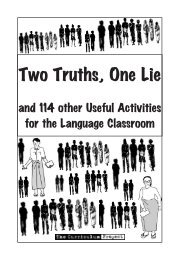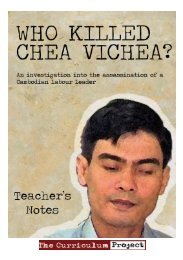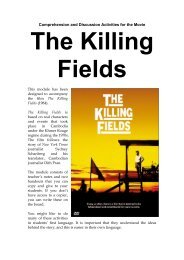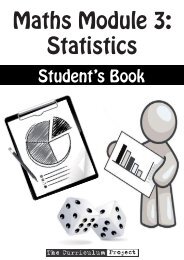Teacher's Guide - The Curriculum Project
Teacher's Guide - The Curriculum Project
Teacher's Guide - The Curriculum Project
- No tags were found...
Create successful ePaper yourself
Turn your PDF publications into a flip-book with our unique Google optimized e-Paper software.
International Trade (cont’d)2. SubsidiesAsk the students to read through the first paragraph. <strong>The</strong>n ask students to readthrough the text on their own. Elicit words that they don’t know. Ask if they, orother students, can guess the meaning. If not, give them a dictionary to look it upand tell the class. Ask them some questions to check understanding (without lettingthem look at the text):What is a subsidy?In which economic sector are subsidies most commonly used?What kind of products does the EU CAP subsidise?Discussion1. Why do you think the EU pays so much money to its farmers? Who is the EUprotecting the farmers from? Who else in the world produces sugar, milk, meat,cotton, tobacco, etc?<strong>The</strong> answer is that the EU is trying to protect its farmers against farmers in developing countrieswho can produce these products more cheaply. <strong>The</strong> EU pays its farmers a lot of money so thatthey can lower their prices and be competitive in the international market.Subsidies and developing countriesAsk students to read aloud one sentence of this paragraph in turn.On Your Own2. True or false. Give the students 5-10 minutes to read the paragraph on their ownand decide on the following statements. If they think a statement is ‘false’, theymust give a correct statement.<strong>The</strong>n elicit answers from individual students and check agreement with the rest ofthe class.1. Developed countries use subsidies to protect the economies of deveoping countries.Answer: False. Developed countries use subsidies to protect their own economies.2. Subsidies and import tariffs in developed countries help developing countries tosell products to them.Anwer: False. Subsidies and tariffs in developed countries make it more difficult fordeveloping countries to sell products to them.3. Subsidies help farmers in developed countries to lower the prices of their products.Answer: True.4. Developing countries don’t use subsidies to protect their producers.Answer: False. Developing countries also use subsidies, ususally to protect theirproducers against producers in other developing countries.Discussion3. Put students into groups of 3-5. Ask them to look at the picture and discuss themeaning of the picture.<strong>The</strong> picture shows that the world’s 30 richest countries spend $305 billion per year to protecttheir agricultural industries, often against farmers in developing countries. In return, these 30countries give $50.6 billion in aid to developing countries. <strong>The</strong> question is, would developingcountries need this aid (or so much of it) if they were able to compete fairly with farmers indeveloped countries?Ask one student to read the last paragraph and check understanding.<strong>The</strong> <strong>Curriculum</strong> <strong>Project</strong> ECONOMICS: an introduction - Teacher’s <strong>Guide</strong>58













![[Eng] Nov 2012 DRAFT - The Curriculum Project](https://img.yumpu.com/45590859/1/184x260/eng-nov-2012-draft-the-curriculum-project.jpg?quality=85)


